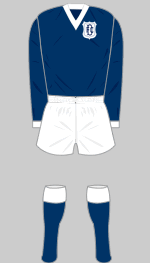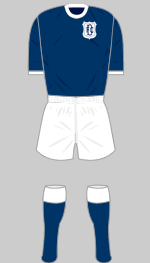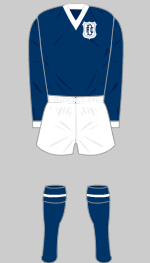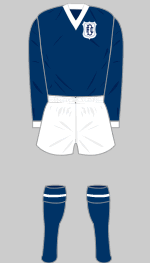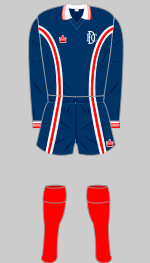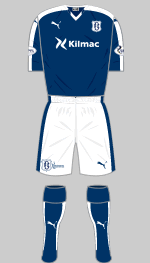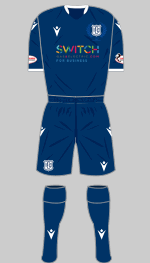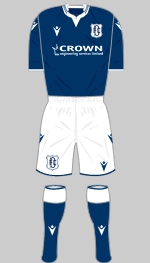
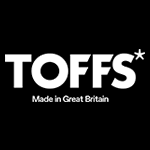
Dundee
Formed 1893
Elected to Scottish League 1893
Withdrew from Scottish Division One 1917. Reinstated 1919
Kit History
East End
1877
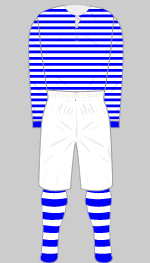
1877-1886 n
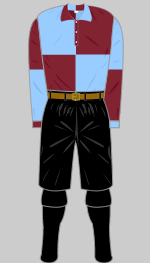
1886-1888 n
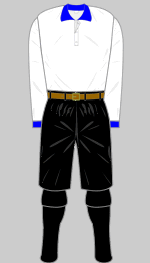
1888-1889 n
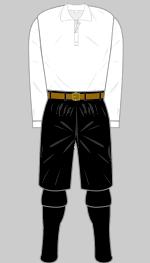
1889-1890 n
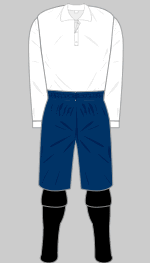
1890-1892 n
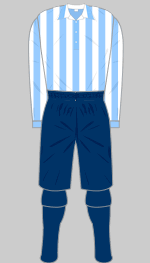
1892-1893 t
Our Boys
1877

1877-1882 n
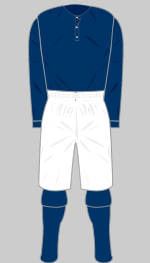
1882-1886 n
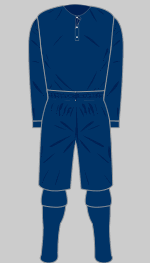
1886-1887 n
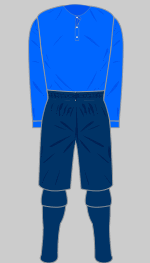
1887-1893 n
Dundee
1893
Formed by the merger of Our Boys and East End.

1893-1896 alt a n

1893-1894 alt t
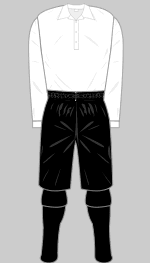
1896-1902 n v
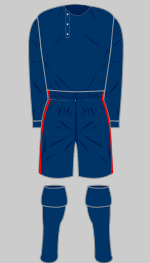
1902-1903 a n t v
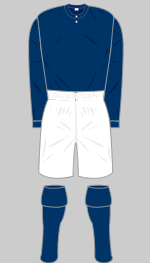
1903-1909 a n u
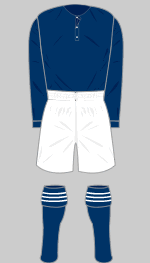
1909-1914 a n
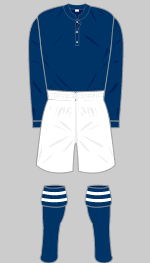
1919-1921 a n
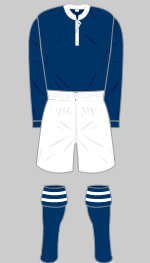
1921-early1923 n
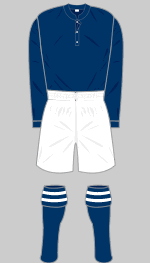
late1923-1925 n
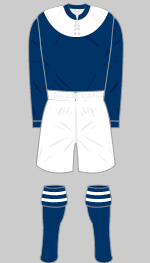
1925-1926 a n
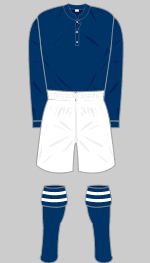
1926-1928 n
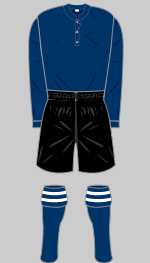
1927-1928 away n
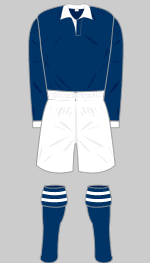
1928-1933 n
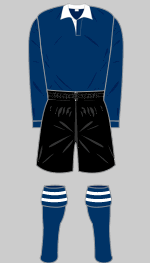
1928-1929 away n

1933-1934 a n
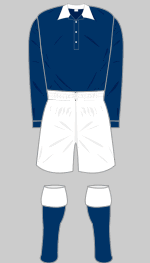
1934-1936 n
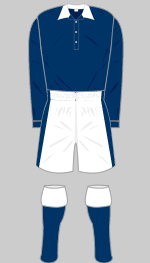
Oct 1936-1945 a b n
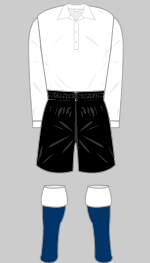
1945-Feb 1946 n t
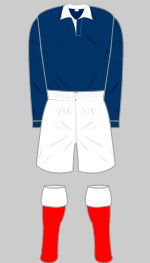
Feb-April 1946 y
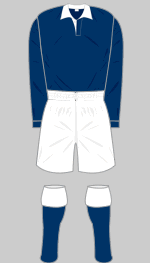
1946-1952 a j n t
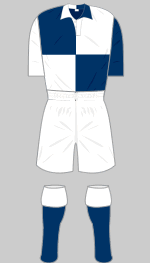
Aug-Sept 1952 w
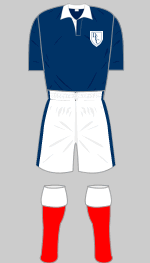
Sept 1952-1954 a n y
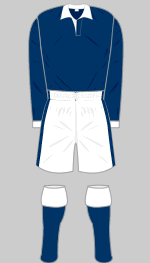
1954-1955 y

1955-1956 n y
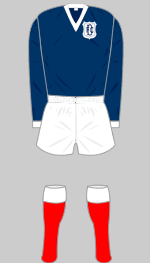
1956-1957 y
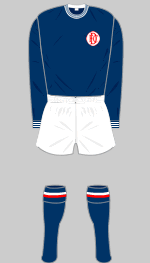
1970-1971 n
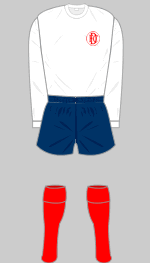
1971-1972 n u
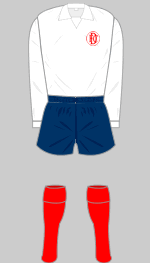
1972-Sept 73 y
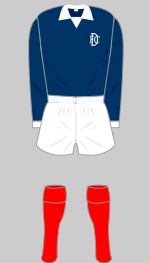
Sept 73-1976 a b n y
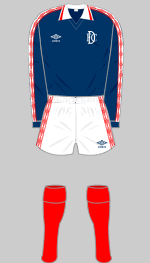
1980-1983 c l
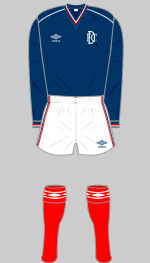
1983-1985 l t
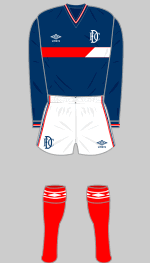
1985-1987 l x z
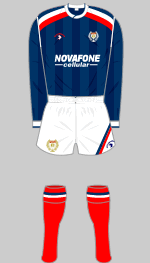
1987-1989 l m q s y
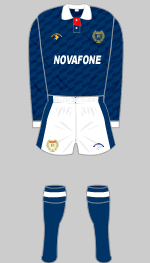
1989-1990 m q y
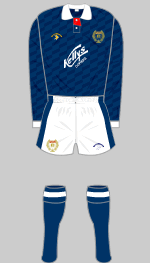
1990-1991 l q
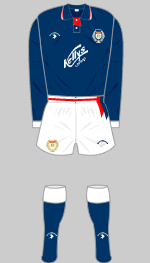
1991-1992 l q
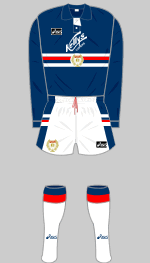
1992-1993 l q y
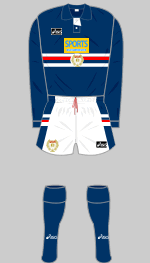
1993-1994 q
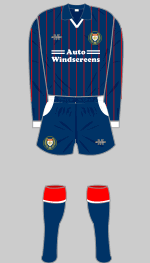
1994-1995 l q
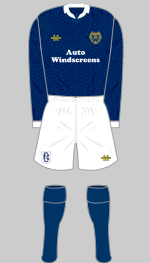
Aug-Sept 1995 l q y
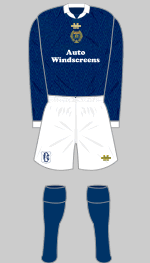
Sept 95-1996 y
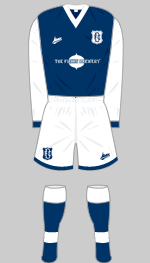
1996-1998 l q
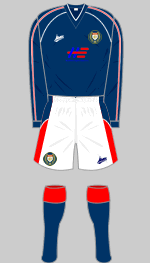
1998-1999 o
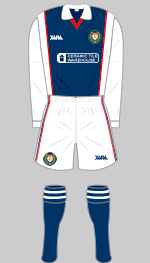
1999-2000 i q
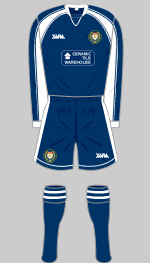
2000-2001 i j q
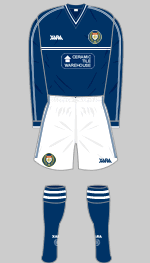
2001-2002 f q y
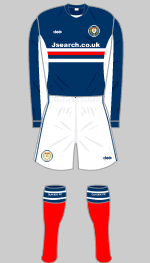
2002-2003 g i r y
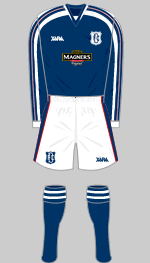
2003-2004 i k q y
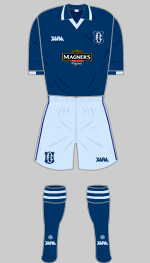
2003-2004 Eur t
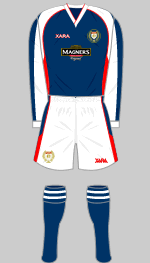
2004-2005 g j
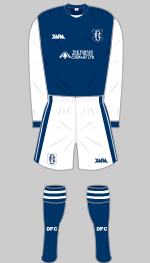
2005-2006 g
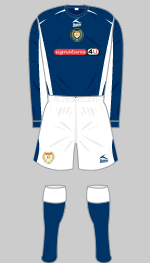
2006-2007 h q
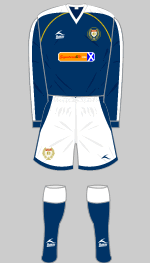
2007-2008 h
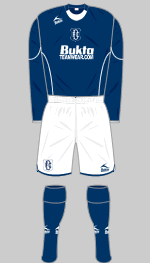
2008-2009 h p
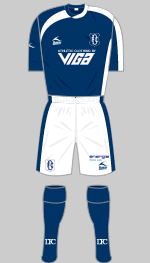
2009-2010 h y
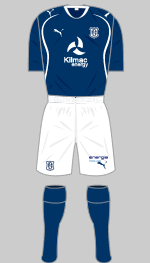
2010-2011 h
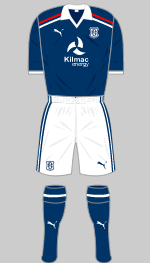
2011-2012 h
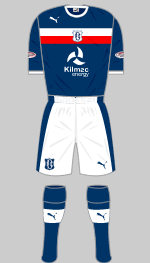
2012-2013 h
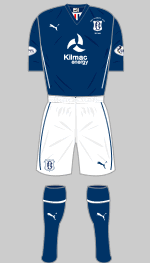
2013-2014 h
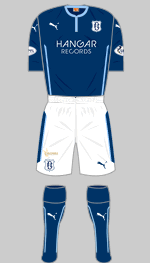
2014-2015 h
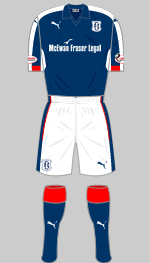
2016-2017 h
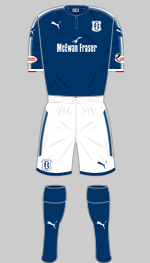
2017-2018 h
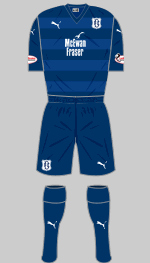
2018-2019 h
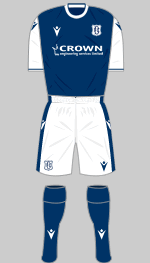
2020-2021 h
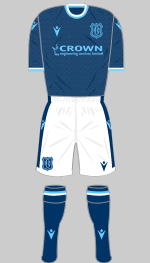
2021-2022 h

Background
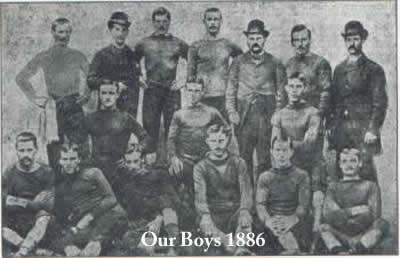 In the late-eighteenth century, two clubs were dominant in the city of Dundee. East End and Our Boys were both formed in 1877 played in the Northern League between 1891 and 1893, sharing the title in 1892.
In the late-eighteenth century, two clubs were dominant in the city of Dundee. East End and Our Boys were both formed in 1877 played in the Northern League between 1891 and 1893, sharing the title in 1892.
In May 1893 the two clubs merged to form Dundee FC with the intention of making an application to join the Scottish Football League. The new club was duly elected the following month to the newly formed First Division. In their first season they alternated between wearing the striped shirts of East End and the navy blue of Our Boys according to the club historian, Norrie Price.
Dundee had to apply for re-election in 1894, 1895 and again in 1899 (this was before automatic promotion and relegation). Contemporary press cuttings found by Kjell Hanssen and Donald Gellatly indicate Dundee switched from white and black to "dark blue semmets and pants, the latter being relieved with a nice red stripe down the side," at the start of the 1902-03 season. Their fortunes now improved and they finished as runners-up in both League and Cup. It is tempting to suppose that this success was the reason navy became the team's traditional colour.
The first evidence we have of a crest comes from a battered programme from a fund raising bazaar held in 1899. This shows the intertwined letters DFC (but in a different 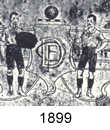 pattern to modern versions) as well as distinctive diagonal bands, a motif that would appear in later versions. Also worth noting are the players drawn on each side wearing the white shirts of the period.
pattern to modern versions) as well as distinctive diagonal bands, a motif that would appear in later versions. Also worth noting are the players drawn on each side wearing the white shirts of the period.
In 1909 Dundee finished one point behind champions Celtic and the following year they won their first senior honour, beating Clyde in the Scottish Cup final. They played no fewer than ten ties and five replays in this campaign as well as replaying the final.
In 1917 Dundee, Raith Rovers and Aberdeen withdrew
from the Scottish First Division due to the difficulty of
wartime travel. They returned in 1919 and had a strong run of success
(finishing fourth three times in succession and reaching the Scottish
Cup final in 1925) but during the 1930s they began to struggle and in
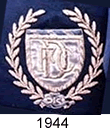 1939, Dundee were relegated to the Scottish Second Division.
1939, Dundee were relegated to the Scottish Second Division.
After the Second World War, Dundee started out in the new Division B (second tier), winning the championship at the first time of asking. The white shirts worn in the 1945-46 season were probably the result of the clothing rationing that forced a number of teams to turn out in unfamiliar colours. The club crest shown here was worn on official blazers (not team shirts). In February 1946 dark blue shirts were reinstated.
In 1949 they became within a whisker of winning
Division A, finishing one point behind Rangers after a 1-4 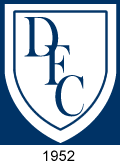 defeat by
Falkirk cost them the title. They did, however, win the League Cup in
both 1952 and 1953.
defeat by
Falkirk cost them the title. They did, however, win the League Cup in
both 1952 and 1953.
In August 1952, Dundee's manager, George Anderson, introduced new, quartered shirts and these were worn in the opening matches of the season. The players hated them and several supporters compalined about them in the press. When Anderson was take ill in September his assistant, Reggie Smith, took over the reins and, at the suggestion of the players, threw unpopular new shirts in the bin.
The earliest occasion HFK can find of the team wearing a crest is in the 1952 Scottish Cup final, which they lost 0-4 to Motherwell. Oddly they wore white shirts and dark blue knickers in this game. It was also worn (on the Dee's traditional dark blue shirts) in the 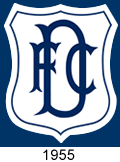 1953 League Cup final and on the tour of South Africa that followed, on which they wore extraordinary tartan shirts (See Iconic Away Kits).
1953 League Cup final and on the tour of South Africa that followed, on which they wore extraordinary tartan shirts (See Iconic Away Kits).
The more familiar monogram version appeared around 1955 and became one of the most recognisable badges of all UK clubs.
The Dark Blue’s greatest triumph came in
1962 when they finally won the First Division title and Scottish League
Champion’s flag was at last flown over Dens Park. The following
season they reached the semi-final of the European Cup where they were
knocked out by AC Milan, who went on to win the competition. During
the 1967-68 season they 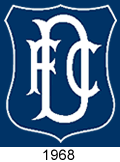 reached the League Cup final once again but
were beaten by Celtic and were knocked out of the Inter City Fairs Cup
(the forerunner of the UEFA Cup) by Leeds United in the semi-final.
reached the League Cup final once again but
were beaten by Celtic and were knocked out of the Inter City Fairs Cup
(the forerunner of the UEFA Cup) by Leeds United in the semi-final.
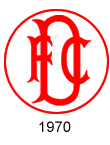 In 1968-69 the colours of the monogram were reversed and two seasons later, rendered in red on a white disc when red trim was reintroduced to the strip.
In 1968-69 the colours of the monogram were reversed and two seasons later, rendered in red on a white disc when red trim was reintroduced to the strip.
The Seventies was a decade of disappointment. They reached the Scottish FA Cup semi-finals five times only to be beaten by Celtic on every occasion and while they always finished in the top third of the table, they were not quite good enough to challenge for the title. The change to white shirts in 1971-72 may have been an attempt to change their fortunes but it was deeply unpopular and the familiar navy tops quickly returned.
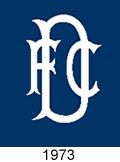 Dundee did, however, win another League Cup in 1973-74, ironically
beating Celtic in the final. The monogram that season was stitched directly onto the shirts without a supporting shield.
Dundee did, however, win another League Cup in 1973-74, ironically
beating Celtic in the final. The monogram that season was stitched directly onto the shirts without a supporting shield.
The restructuring of 1975 exposed Dundee's
weakness and in 1976 they finished level on 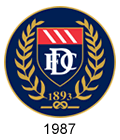 points with neighbours Dundee
United and Aberdeen and were relegated because of their inferior goal
average. In 1979 they returned as Division One champions, were immediately
relegated and promoted once again the following season.
points with neighbours Dundee
United and Aberdeen and were relegated because of their inferior goal
average. In 1979 they returned as Division One champions, were immediately
relegated and promoted once again the following season.
A brand new crest was introduced in 1987, which retained the old DFC cypher within a more elaborate design that was based on the official version that appeared after the Second World War on official blazers and publications. This badge endured until 2008 and still appears on the club web site, although the simplified version also made several 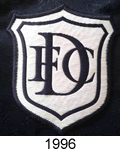 appearances.
appearances.
The Dees struggled to keep their Premier Division status, enduring three spells in the First Division. The last of these spells witnessed the Dees appearing in another League Cup final, losing out to Aberdeen in 1995/96. A solid league campaign 1997/98 brought promotion to the newly formed Scottish Premier League. Dundee FC recorded their highest league position in 30 years, finishing fifth. This was the first time that Dundee FC had finished above their nearest rivals, Dundee United since the inception of the Premier 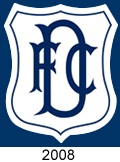 Division in Scottish football in 1975.
Division in Scottish football in 1975.
The new millennium signaled the arrival of the colourful Italian, Ivano Bonetti and a host of big name stars, including Argentinian World Cup star, Claudio Caniggia. An appearance in the Scottish Cup final in 2003, where they lost out to Rangers 1-0 and qualification for the UEFA Cup after an absence of almost 30 years were the reward. The policy of signing exciting foreign talent proved unsustainable, however, and in 2003 Dundee FC went into administration. They survived, in part due to the fund-raising efforts of the supporters but a disastrous 2004-05 campaign end took them back into the Scottish First Division.
In October Dundee entered administration again after failing to negotiate a reduction in their unpaid tax bill of £360,000. After imposing a record 25-point penalty on the club, an SFL spokesperson stated, "Clubs have to realise that they can't treat their Her Majesty's Revenue and Customs tax obligations as something akin to a credit card," and implied further sanctions would follow if the club had not left administration by March. In the absence of any other bids, control passed to Dundee FC Supporters' Society Ltd who acquired a majority shareholding and creditors voted to accept a payout of 6p in the pound (with HMRC, as is their policy, objecting). Had it not been for the points deduction, Dundee would have almost certainly won the division title.
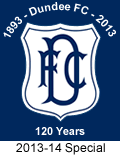 Famously, Dundee’s Dens Park is right next
door to Dundee United’s Tannadice. While a ground sharing arrangement
would allow one or both clubs to sell their valuable city centre real-estate
seems logical, tradition and pride make it unlikely this will ever happen.
Famously, Dundee’s Dens Park is right next
door to Dundee United’s Tannadice. While a ground sharing arrangement
would allow one or both clubs to sell their valuable city centre real-estate
seems logical, tradition and pride make it unlikely this will ever happen.
In July 2012, Dundee, who had finished second in the First Division, were voted into the Scottish Premier League to replace Rangers after the "newco" Glasgow club was denied admission but were relegated at the end of the season.
Commemorative script was added to the crest for the club's 120th anniversary although this did not always appear on match shirts. Fittingly, on the last day of the season, 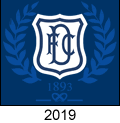 Dundee clinched the SPFL Championship (as the second tier was now called) and automatic promotion to the Premier League.
Dundee clinched the SPFL Championship (as the second tier was now called) and automatic promotion to the Premier League.
Dundee were back in the Scottish Championship for the 2019-20 season for which the traditional crest was embellished with laurel leaves and the date of the club's formation.
The team finished as runners-up in the 2020-21 Championship and went on to win the play-offs and return to the Premiership. Unfortunately the team had an awful season back in the top tier and finished bottom of the table with just 29 points.
With thanks to Dave Glen.
Sources
- (a) Dundee FC - Images of Sport (Paul Lunney 2001)
- (b) London Hearts
- (c) Ayr United FC - Images of Sport (Duncan Carmichael 2002)
- (d) Relichtie Plus
- (e) Riccardo Bertani
- (f) Dundee Rivals
- (g) Colours of Football
- (h) Dundee FC Official Website
- (i) Classic Kits
- (j) e-bay
- (k) Pars Database
- (l) SNSpix
- (m) Bob Jamieson
- (n) Alick Milne
- (o) Craig McGregor
- (p) Football Shirt Culture
- (q) Donald Gellatly
- (r) Kenny Ross
- (s) Harry (Dundee Mad)
- (t) Donald Gellatly (HFK Research Associate)
- (u) Keith Ellis
- (v) Kjell Hanssen
- (w) Donald Gellatly (researched by Kenny Ross)
- (x) Ryan Paterson
- (y) Ian McConnel
- (z) Nicky McCrimmon
Crests are the property of Dundee FC.
